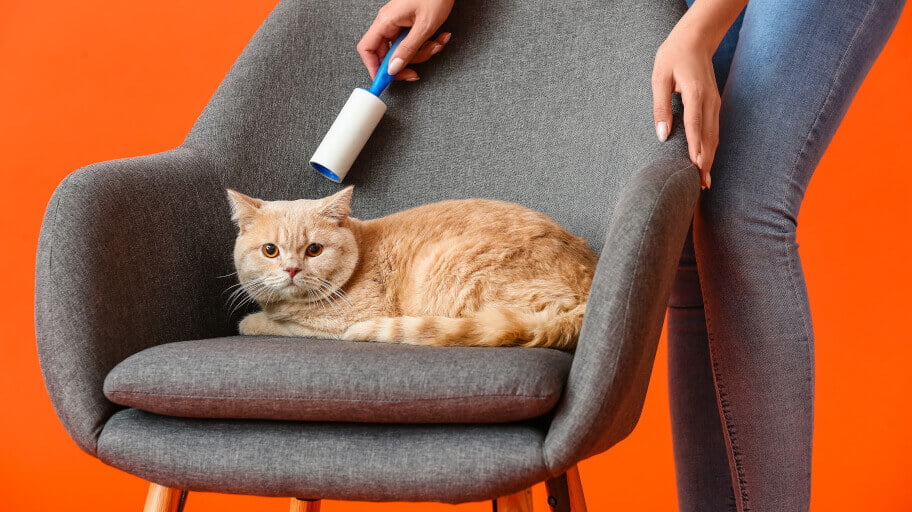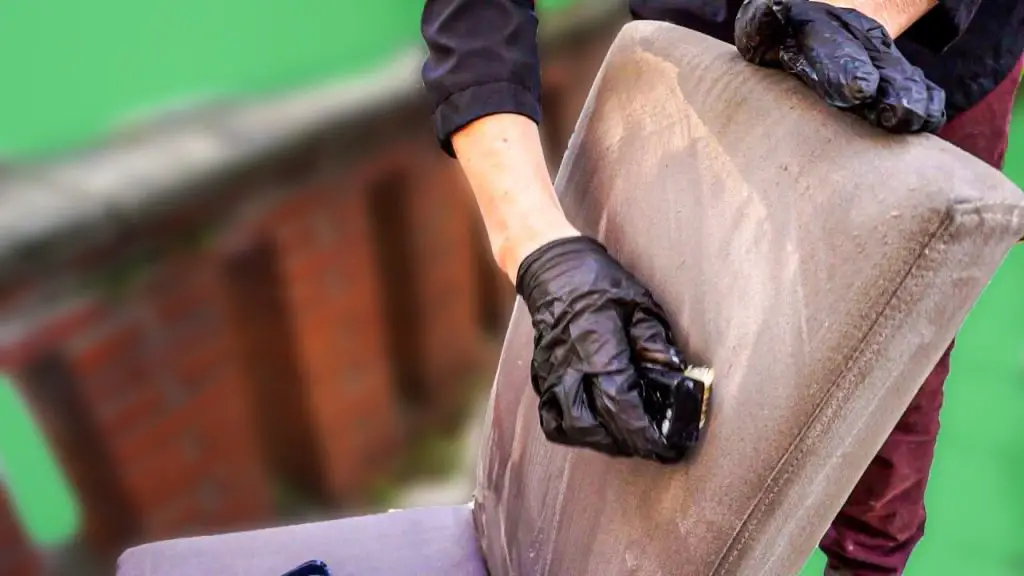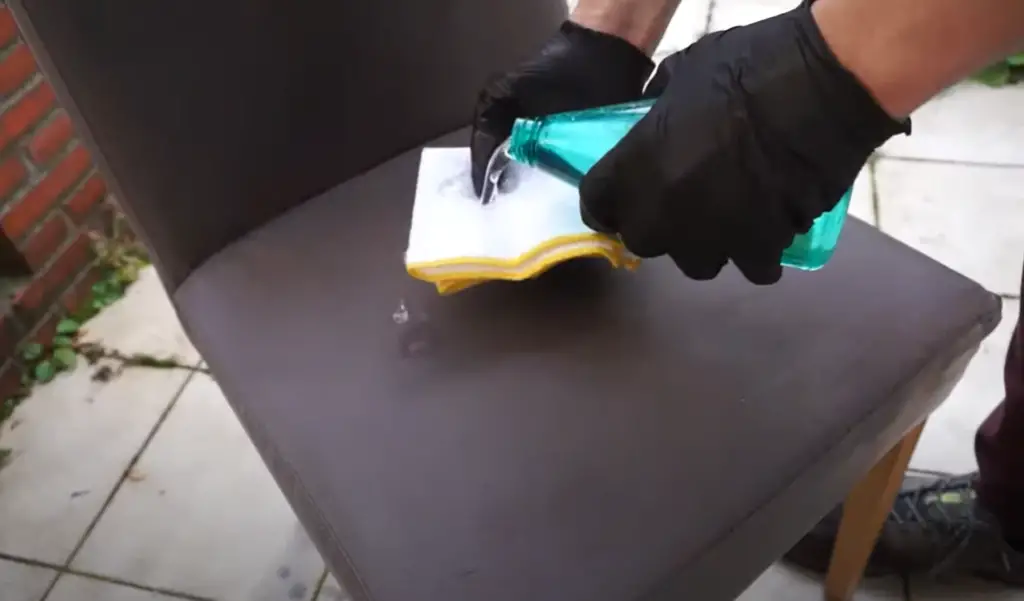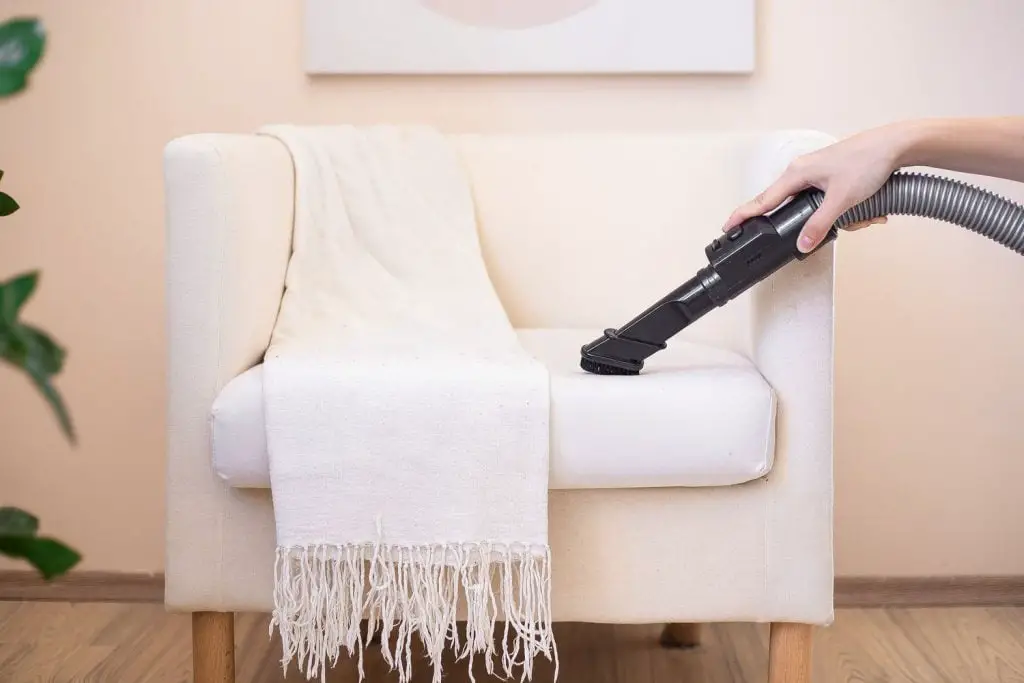How to Clean Chairs at Home, vacuum the upholstery to remove dust, then use a suitable cleaner for the material. Dab spills immediately to prevent stains on fabric chairs.
Maintaining clean chairs is essential for a tidy home environment and to ensure the longevity of your furniture. Regular cleaning not only improves the appearance of chairs but also contributes to a healthier living space by reducing allergens and bacteria.
Different chair materials, from leather to fabric, require specific cleaning methods to avoid damage. Spot cleaning and the occasional deep clean can rejuvenate your seating and keep it looking fresh for visitors and daily use. The tools and cleaning solutions used can often be found in a typical household, making the process both convenient and cost-effective. Remember to always check the manufacturer’s instructions before applying any cleaning agents to prevent discoloration or fabric damage. With the right approach, you can easily tackle chair cleaning as part of your routine home maintenance.
Introduction To Chair Cleaning
A clean home involves tidy and spotless furniture. Chairs, as essential pieces of furniture, require regular maintenance to keep them looking as good as new. A well-cleaned chair not only enhances the aesthetics of a space but also ensures durability and hygiene.
Understanding The Importance Of Chair Maintenance
Regular cleaning extends the life of your chairs. It prevents the buildup of dirt and allergens. Spills and stains when left unattended can cause permanent damage. Thus, consistency in chair maintenance is crucial.
Identifying Different Types Of Chairs And Materials
Chairs are available in various designs and materials. Knowing the chair’s makeup is key to choosing the right cleaning method. Material types commonly include wood, metal, plastic, wicker, and upholstered fabrics. Each warrants a specific care approach.
| Chair Type | Material | Cleaning Method |
|---|---|---|
| Wooden Chair | Wood | Soap and water, polish |
| Metal Chair | Metal | Mild detergent, dry cloth |
| Plastic Chair | Plastic | Soapy water, gentle scrub |
| Wicker Chair | Wicker | Vacuum, damp cloth |
| Upholstered Chair | Fabric | Stain remover, vacuum |

Preparing For The Clean
Cleaning chairs at home is like giving your furniture a fresh start. Dust, spills, and stains sneak into our lives no matter how careful we are. Preparing for the clean sets the stage for success, ensuring that your chairs not only look great but are cared for properly.
Gathering Necessary Cleaning Supplies
Before diving into the task, it’s vital to have all your tools at the ready. You wouldn’t want to pause mid-clean to find a missing spray or cloth! Here’s what you’ll typically need:
- Vacuum cleaner with an upholstery attachment
- Microfiber cloths for gentle wiping
- Mild detergent suitable for the chair’s material
- Bucket for mixing cleaning solutions
- Soft-bristled brush for tough spots
- Rubber gloves to protect your hands
| Upholstery type | Cleaning agent |
|---|---|
| Fabric | Warm water with mild detergent |
| Leather | Leather cleaner or vinegar solution |
| Wood | Wood polish or soap and water |
Creating A Step-by-step Plan Of Action
Structuring your approach ensures every inch of the chair gets the attention it deserves. Adhering to a specific sequence enhances efficiency and prevents work overlap.
- Vacuum the chair to remove loose dirt and dust.
- Spot clean any visible stains.
- Wash surfaces with appropriate cleansers.
- Rinse with a damp cloth to remove soap residue.
- Dry the chair completely to avoid moisture damage.
Remember, drying times can vary. Always allow chairs to dry fully before putting them back into use.
General Chair Cleaning Tips
Clean chairs bring comfort and beauty to any home. It’s important to know the right tips to keep them looking great. Here are basic steps to tackle dirt and grime on various chairs. Follow these simple methods to ensure your chairs stay fresh and last longer. Always check the manufacturer’s label before you start, to avoid damaging the material.
Dusting: The First Step In Chair Cleaning
Dust accumulates on surfaces daily, making it important to clean regularly. Use a soft microfiber cloth or a duster to gently wipe down wooden, metal, or plastic chairs. For fabric chairs, consider a lint roller to pick up pet hair and loose dirt.
Vacuuming Upholstery And Crevices
Upholstered chairs require a deeper cleaning. Use your vacuum’s upholstery attachment to remove dirt from the fabric. Don’t forget to vacuum the crevices where crumbs and debris tend to collect. This is a key step in maintaining your chair’s appearance and hygiene.
| Material | Cleaning Tool | Frequency |
|---|---|---|
| Wood | Microfiber Cloth | Weekly |
| Metal | Soft Duster | Bi-Weekly |
| Plastic | Damp Cloth | As needed |
| Fabric | Vacuum with Attachment | Monthly |
- Start with dusting to remove surface particles.
- Vacuum to get rid of deeper dirt in fabric chairs.
- Focus on crevices and cracks where crumbs hide.
- Check labels for specific cleaning instructions.
Spot Cleaning Techniques
Chairs at home gather stains over time. Spot cleaning is a direct way to tackle these marks. Grab supplies like cloths, brushes, and cleaners. Let’s dive into some effective techniques together.
Identifying Common Stains And Appropriate Removers
Different stains need specific treatment. Know what you’re dealing with first.
| Stain Type | Remover |
|---|---|
| Food | Mild dish soap |
| Ink | Isopropyl alcohol |
| Grease | Baking soda paste |
| Coffee | Vinegar solution |
Diy Cleaning Solutions Vs. Commercial Cleaners
Commercial cleaners are quick and effective. DIY solutions can be safer and cheaper.
- DIY: Mix vinegar, water and soap.
- Store-bought: Choose eco-friendly options when possible.
Test any solution on a small, hidden chair spot first to prevent damage.
Deep Cleaning Fabric Chairs
Over time, fabric chairs gather dust and stains, diminishing their beauty and freshness. Regular cleaning helps, but nothing beats a deep cleaning session to rejuvenate your beloved chairs. Deep cleaning fabric chairs ensures that hidden grime and lingering odors are eradicated. This guide will walk you through step-by-step methods to make your fabric chairs look and smell as good as new.
Steam Cleaning For A Thorough Refresh
Steam cleaning is an effective way to deep clean fabric chairs. It uses hot steam to loosen and remove dirt from the fabric fibers. This method also kills germs and dust mites. Before you begin, vacuum the chair to remove loose dirt. Check the fabric care label for any specific instructions. If it’s safe, use a steam cleaner with an upholstery attachment.
- Fill the steam cleaner with water and, if applicable, an appropriate cleaning solution.
- Test on a small, inconspicuous area to ensure no color bleeding or fabric damage occurs.
- Move slowly across the fabric, allowing the steam to penetrate and lift the dirt.
- After steam cleaning, let the chair dry completely before using it again.
Handling Delicate Fabrics With Care
Delicate fabrics need special treatment to avoid damage. First, identify the type of fabric you are dealing with by checking the manufacturer’s label. For sensitive materials, avoid harsh chemicals and too much water.
- Gently vacuum the chair with a soft brush attachment to remove dust.
- Use a dry cleaning solvent specifically designed for delicate fabrics.
- Apply the solvent to a clean, white cloth and dab the stained areas.
- Always blot gently instead of rubbing to prevent damage to the fibers.
- Allow the chair to air dry, avoiding direct heat or sunlight.
By following these methods, you ensure that your fabric chairs get the care they require without compromising their integrity. Always remember to check the cleaning codes and instructions specific to your chair’s fabric. A clean, fresh chair enhances the comfort and aesthetics of any home.
Maintaining Leather Chairs
Leather chairs bring a touch of elegance to any home. Nevertheless, they require special care to stay pristine. The right approach extends their life and keeps them looking their best. Let’s delve into the two key facets: cleaning and conditioning leather chairs.
Proper Cleaning Agents For Leather
Choosing the right cleaner is crucial for leather. Leather is skin and needs gentleness, just like ours. Stick to cleaners designed specifically for leather to prevent damage.
- Mild soap: It’s safe and effective for dirt and spills.
- Commercial leather cleaner: Use as directed for optimal results.
Before applying any product, always do a patch test in an unseen area.
Conditioning To Prolong Life And Appearance
Leather thrives with regular conditioning. Conditioners replenish lost moisture and prevent cracks.
Use these tips for the best results:
- Clean first: This removes debris before conditioning.
- Apply conditioner: Use a soft cloth in circular motions.
- Avoid over-conditioning: Twice a year is ample for most leathers.
Wooden Chair Care
Wooden chairs add timeless elegance to any home but require specific care to maintain their beauty and integrity. Regular cleaning and maintenance can significantly extend the life and appearance of your cherished wooden furnishings. Let’s delve into the best practices for keeping these pieces in tip-top shape, focusing on polishing and addressing common issues like scratches and water marks.
Polishing Wood Surfaces: Techniques And Products
To keep your wooden chairs shining, a good polish is key. The process is straightforward and, with the right products, can protect and enhance the wood’s natural grain.
- Choose the right polish for your type of finish. Beeswax and oil-based polishes offer a natural sheen.
- Apply a small amount of polish with a soft, lint-free cloth.
- We recommend polishing in gentle, circular motions to help the product penetrate and nourish the wood.
- Allow the polish time to dry, then use another clean cloth to buff the surface to a shine.
Addressing Scratches And Water Rings
Scratches and water rings can mar the surface of wood, but with a few tricks, you can minimize their appearance.
| Issue | DIY Solution |
|---|---|
| Light Scratches | Use a walnut or pecan. Rub the meat over the scratch. |
| Deep Scratches | A color-matched wood filler works well. Sand gently after drying. |
| Water Rings | Apply toothpaste. Rub gently with a soft cloth, then wipe clean. |
Always test these solutions in an inconspicuous spot for the best results. Regular care and attention keep your wooden chairs looking as good as new.

Cleaning Metal And Plastic Chairs
Maintaining clean and shiny chairs enhances the beauty of your home. Let’s dive into proper care for metal and plastic chairs.
Using The Right Cleaners For Hard Surfaces
Cleaning hard surfaces requires attention to detail and the correct cleaning agents.
- Soap and water work well for basic grime.
- For tougher stains, use a mix of vinegar and water.
- Baking soda can remove stubborn marks when applied with a sponge.
Always test cleaners on a small area first. This prevents potential damage.
Protecting Chairs From Rust And Discoloration
Preserving your chairs’ look is vital.
- For metal chairs, apply a layer of car wax to protect against rust.
- Plastic chairs benefit from UV-protective spray to prevent fading.
Keep chairs out of prolonged wet conditions and direct sun when possible.
| Chair Material | Cleaning Agent | Protection Method |
|---|---|---|
| Metal | Soap, Vinegar, Baking Soda | Car Wax |
| Plastic | Soap, Vinegar | UV-Protective Spray |
Specialty Chairs: Wicker, Rattan, And Others
Imagine inviting friends over and your specialty chairs steal the show. Wicker, rattan, and similar materials can make that impact. Yet, cleaning them requires a gentle touch. Take pride in your unique seating by mastering the art of caring for these delicate beauties.
Navigating The Challenges Of Uncommon Materials
Chairs made from wicker, rattan, or other unusual materials pose distinctive challenges. Their intricate weaves can trap dust and dirt. The natural fibers can also be sensitive to harsh cleaning agents. Bold action is necessary but with a soft approach to preserve their intricate designs.
Effective Cleaning Methods For Delicate Constructions
Regular dusting is key to keeping these chairs looking fresh. Use a soft-bristle brush or a vacuum with a brush attachment to gently remove surface debris.
- Sponge cleaning: Dip a sponge in a soapy water solution, wring it out well, and gently wipe the surfaces.
- Air dry: Allow chairs to air dry completely before use.
- Protective oils: Apply a thin coat of linseed or lemon oil for protection when fully dry.
Avoid soaking wicker or rattan, as excessive moisture can damage the fibers. Spot clean spills immediately to prevent stains.
| Cleaning Task | Tool | Cleaning Agent |
|---|---|---|
| Dusting | Soft-bristle brush | – |
| Light Cleaning | Sponge | Mild soapy water |
| Protection | Soft cloth | Linseed/Lemon oil |
For spillages, blot the area with a clean cloth. Immediately dry with a hairdryer on a cool setting if needed. Check for mold spots; remove them using a soft brush and a bleach-water solution.
Yearly deep cleans keep your chairs in top shape. For these, consider a professional cleaning service familiar with such materials.
Eco-friendly Cleaning Options
Embracing eco-friendly cleaning methods is not only better for the earth but also for your home. When tackling the chore of cleaning chairs, natural solutions come to the rescue. These options ensure safety for your family and pets, and they keep harsh chemicals out of our water systems. Let’s explore how you can get your chairs spotless while being kind to the environment.
Natural Cleaning Agents For A Greener Clean
Natural cleaning agents tackle dirt effectively without sacrificing the environment. A variety of everyday household items double as safe, non-toxic cleaners.
- White Vinegar: An all-purpose cleaner, perfect for deodorizing and removing light stains.
- Baking Soda: Great for lifting grease and eliminating odors.
- Lemon Juice: It’s a natural bleaching agent that also adds a fresh scent.
- Olive Oil: Works wonders as a polish for wood chairs.
- Castile Soap: A gentle yet powerful cleaner for various types of upholstery.
Preventing Environmental Impact Through Sustainable Practices
Sustainable cleaning practices are key in reducing environmental impact. Choose reusable cloths over paper towels to cut down on waste. Implement a regular cleaning routine to avoid the buildup of dirt and grime, which can require harsher methods to remove. Opting for sustainable practices doesn’t just help the environment; it also saves you money in the long run.
| Practice | Benefits |
|---|---|
| Reusable Cloths | Reduces waste, saves trees, and is cost-effective over time. |
| Regular Cleaning | Minimizes the need for strong chemicals, maintains the chair’s appearance. |
Safety And Preventative Measures
Keeping your home clean is essential, but safety always comes first. When it comes to cleaning chairs, taking the right precautions can prevent damage to the furniture and ensure your well-being. Follow these steps to maintain both your chairs and your health.
Avoiding Damage During The Cleaning Process
Care is key when preserving the look and lifespan of your chairs. Use the right products and avoid harsh techniques:
- Check manufacturer’s guidelines: Always look for cleaning instructions.
- Test first: Try cleaning products on a small, unseen chair area.
- Use gentle materials: Soft cloths or sponges are best for wiping.
- Avoid excess water: Too much liquid can damage the fabric or wood.
Using Protective Gear When Necessary
Some cleaning agents are strong and may hurt your skin or eyes. Protect yourself properly:
| Cleaning Task | Protective Gear |
|---|---|
| Using chemical sprays | Gloves, Masks |
| Scrubbing stains | Apron, Eye Protection |
| Vacuuming | Ear Plugs (for loud machines) |
Remember, dress for the job! Wearing long sleeves and pants can prevent skin irritation.

Wrapping Up: Post-cleaning Care
After a thorough cleaning session, your chairs look spotless. But the job’s not done until they’re fully dry and protected for future use. Proper post-cleaning care ensures your chairs won’t become a breeding ground for mildew or quickly gather new dirt. Let’s lock in that clean with the right drying and maintenance techniques.
Drying Chairs Properly To Avoid Mildew
Damp chairs may invite unwanted guests – like mold and mildew. To keep them at bay, here’s how to dry chairs effectively:
- Outdoor Sun-Drying: Set chairs outside to dry in the sun. Sunlight is a natural disinfectant.
- Well-Ventilated Space: Place chairs in a room with good air circulation or near a fan.
- Cloth Wipe-Down: Use a dry towel to blot excess moisture from upholstery or cushions.
Remember to rotate or flip cushions for even drying.
Tips For Regular Maintenance To Keep Chairs Clean Longer
Kick back in clean chairs longer with these simple maintenance tips:
- Vacuum Regularly: A quick vacuum every week removes crumbs and dust.
- Immediate Spot Cleaning: Treat spills right away to prevent stains.
- Use Chair Covers: Slip on chair covers to shield them from daily wear and tear.
Follow the manufacturer’s guidelines for specific fabric care.
Frequently Asked Questions For How To Clean Chairs At Home
What Is The Best Way To Clean Fabric Chairs?
To clean fabric chairs, vacuum first to remove loose particles. Then, make a solution of warm water and gentle detergent. Use a soft-bristled brush to lightly scrub. Blot with a damp cloth and dry thoroughly.
Can I Use Vinegar To Clean Leather Chairs?
Yes, mix equal parts of water and white vinegar. Dampen a cloth with the solution, and gently wipe the leather. Always do a patch test first. Finish by drying with a clean cloth and apply a leather conditioner.
How Often Should I Clean My Office Chair?
Office chairs should be vacuumed weekly and deep cleaned every 3 to 6 months. If spills or stains occur, address them immediately to prevent long-term damage and maintain hygiene.
What’s The Safest Way To Clean Wooden Chair Surfaces?
For wooden chairs, use a mixture of warm water and mild dish soap. Wipe with a soft cloth, ringed out from the solution to avoid excess moisture. Dry immediately with another clean cloth to protect the wood.
Conclusion
Cleaning your chairs at home doesn’t have to be daunting. With the right tools and techniques, you can rejuvenate any seat easily. Regular upkeep using these methods ensures longevity and comfort. So, grab your supplies and give your chairs the attention they deserve.
Happy cleaning!

